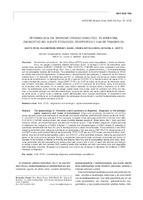Please use this identifier to cite or link to this item:
http://sgc.anlis.gob.ar/handle/123456789/187| Title: | Epidemiologia del sindrome uremico hemolitico en argentina. Diagnostico del agente etiológico, reservorios y vías de transmisión | Other Titles: | The epidemiology of hemolytic uremic syndrome in Argentina. Diagnosis of the etiologic agent, reservoirs and routes of transmission | Authors: | Rivas, Marta Miliwebsky, Elizabeth Chinen, Isabel Deza, N. Leotta, G. A. |
Keywords: | Epidemiología;Síndrome Hemolítico-Urémico;Escherichia coli;Toxina Shiga;Vigilancia Epidemiológica;Argentina | Issue Date: | 2006 | Description: | Escherichia coliproductor de toxina Shiga (STEC) causa casos esporádicos y brotes de diarrea con o sin sangre y síndrome urémico hemolítico (SUH). El serotipo O157:H7 es prevalente, pero existen otros serotipos (O26:H11; O103:H2; O111:NM; O121:H19; O145:NM, entre otros) asociados a enfermedad humana severa. Las toxinas Shiga (Stx1, Stx2 y sus variantes), la proteína intimina, y la enterohemolisina son los principales factores de virulencia. Para establecer la asociación entre enfermedad e infección por STEC se utilizan tres criterios diagnósticos: 1) aislamiento y caracterización del patógeno; 2) detección de Stx libre en materia fecal; y 3) detección de anticuerpos anti-Stx. La vigilancia de las cepas circulantes se realiza mediante técnicas de subtipificación: a) genotipificación de Stx y eaepor PCR-RFLP; b) fagotipificación de cepas O157; y c) electroforesis de campos pulsados. Cepas STEC O157 y no-O157 se aíslan en muestras de diferentes orígenes: humano, animales, alimentos y medio ambiente, y O157:H7 productor de Stx2/Stx2c, eae y exhA-positivo es el serotipo más frecuente. En un estudio caso-control realizado en Buenos Aires y Mendoza en el 2001-2002, se identificaron como factores de riesgo: comer carne mal cocida, estar en contacto con niños con diarrea, y vivir/visitar un lugar con animales domésticos. Lavarse las manos con agua y jabón después de manipular carne cruda, y comer frutas y verduras, fueron identificados como factores protectores. El conocimiento de estos factores contribuirá en la implementación de estrategias de prevención y control fundamentales para disminuir la morbi-mortalidad asociada al SUH. Shiga toxin-producing Escherichia coli(STEC) cause sporadic cases and outbreaks of nonbloody and bloody diarrhea, and hemolytic uremic syndrome (HUS). E. coliO157:H7 is the most prevalent STEC serotype. However, other serotypes (O26:H11; O103:H2; O111:NM; O121:H19; O145:NM, among others) can cause a similar disease spectrum. Shiga toxins (Stx1, Stx2, and their variants), intimin, and enterohemolysin are the main virulence factors. Three different diagnostic criteria are used to determine the frequency of STEC infection: 1) isolation and characterization of STEC strains; 2) detection of specifically neutralizable free fecal Stx; and 3) Serological tests to detect Stx-antibodies. The surveillance of the STEC strains is performed using subtyping techniques: a) genotyping of Stx and eae by PCR-RFLP; b) phage typing of E. coliO157 strains; and c) pulsed-field gel electrophoresis. STEC O157 and non-O157 strains are recovered from clinic, animal, food and environmental samples, and E. coliO157:H7, a Stx2 and Stx2c producer, harboring eaeand ehxA genes, is the most common serotype. During a prospective case-control study conducted to evaluate risk factors for sporadic STEC infection in Mendoza Province and Buenos Aires City and its surroundings during 2001-2002, exposures associated with risk included eating undercooked beef, contact with a child <5 years with diarrhea and living in or visiting a place with farm animals. Both washing hands after handling raw beef, and eating fruits and vegetables were frequently protective. Strategies of prevention and control are necessary to decrease the incidence of STEC infections in Argentina. Fil: Rivas, Marta. ANLIS Dr.C.G.Malbrán. Instituto Nacional de Enfermedades Infecciosas. Servicio Fisiopatogenia; Argentina. Fil: Miliwebsky, Elizabeth. ANLIS Dr.C.G.Malbrán. Instituto Nacional de Enfermedades Infecciosas. Servicio Fisiopatogenia; Argentina. Fil: Chinen, Isabel. ANLIS Dr.C.G.Malbrán. Instituto Nacional de Enfermedades Infecciosas. Servicio Fisiopatogenia; Argentina. Fil: Deza, N. ANLIS Dr.C.G.Malbrán. Instituto Nacional de Enfermedades Infecciosas. Servicio Fisiopatogenia; Argentina. Fil: Leotta, Gerardo A. ANLIS Dr.C.G.Malbrán. Instituto Nacional de Enfermedades Infecciosas. Servicio Fisiopatogenia; Argentina. |
URI: | http://www.medicinabuenosaires.com/revistas/vol66-06/Supl-3/v66-s3-27-32.pdf http://sgc.anlis.gob.ar/handle/123456789/187 |
ISSN: | 0025-7680 | Rights: | info:eu-repo/semantics/openAccess |
| Appears in Collections: | snrd Publicaciones INEI |
Files in This Item:
| File | Description | Size | Format | |
|---|---|---|---|---|
| Medicina(Buenos Aires),2006,66(Supl. 3),27–32.pdf | 43.21 kB | Adobe PDF |  View/Open |
Page view(s)
637
checked on Dec 30, 2025
Download(s)
148
checked on Dec 30, 2025
Google ScholarTM
Check
Items in DSpace are protected by copyright, with all rights reserved, unless otherwise indicated.

